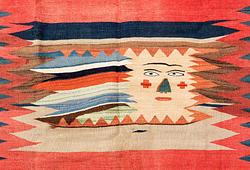Henry Moore
"Upright Motive, Maquette No.4"
1955. Bronze, 28,5 cm, base 1 cm. Edition of 9+1 artist's copy, cast c.1956-62. Foundry: Fiorini Ltd, London
Import VAT
Import VAT (12%) will be charged on the hammer price on this lot. For further details please contact customer service +46 8-614 08 00.
Provenance
Arild Wahlstrøm, Norweigan art collector, (1909 - 1994).
Thence by descent to the present owner.
Literature
A. Bowness (ed.), "Henry Moore, Sculpture and drawings, Sculpture 1955-64, vol. III", London, 1986, no. 381.
More information
Arild Wahlström was a Norwegian industrialist and managing director and later chairman of Sande Tresliperi A/S and Sande Paper Mill A/S. In addition to business and sport, Wahlström had a great interest in art and art collecting, which he shared with his wife Aasta. At their home in Holmenkollen, the couple built up an extensive collection of major Norwegian and international works. Wahlström travelled extensively and liked to combine his trips with visits to galleries and artists. He developed close relationships with a number of artists and met Poliakoff, Henry Moore, Soulanges, Manessier, Singier and many others. Three times he was invited to visit Picasso in the south of France with the gallerist Kahnweiler, but each time business intervened, which was a great disappointment. Wahlström's great interest in Picasso's prints had been awakened after the war, during a business trip to Paris in 1946. On a small side street, the Wahlström couple had discovered a picture of a woman's head in an art shop. ‘It was so beautiful - we were both immediately taken by it. It was something extraordinary.’ The incident led to intensive collecting and resulted in one of the world's largest private collections of Picasso prints, with over 1000 prints. In 1982, Arild Wahlström donated almost 500 of these prints, including the entire Vollard suite, to the National Gallery in Oslo.
Artist
Henry Moore (1898-1986) was a prominent British sculptor and artist who played a crucial role in the development of modern sculpture. His contributions to the art world are exceptional, and his works have had a lasting impact on art history.
Henry Moore was born in Castleford, Yorkshire, and showed an early passion for art. After serving in World War I, he studied at the Leeds School of Art and later at the Royal College of Art in London. It was here that he began exploring forms and materials that would define his artistic career.
Moore was strongly influenced by artists such as Pablo Picasso and Constantin Brancusi. He was also interested in non-Western art and sculpture traditions, particularly African and Oceanic art. These influences shaped Moore's unique style and his interest in exploring abstract forms and the representation of the human body.
One of the most prominent features of Moore's work is his fascination with the human figure. He experimented with abstracting and distorting the body to create sculptures that express a sense of movement, balance, and harmony. His sculptures often display rounded and organic forms, drawn from nature and the landscape around him.
Moore used a range of materials for his works, including stone, bronze, and wood. He was skilled at harnessing the properties of these materials, giving them a sense of life and movement. His sculptures often have a monumental scale and a presence that impacts the surrounding environment.
Throughout his career, Henry Moore also created many public artworks and monuments around the world. His works can be found in parks, museums, and urban environments worldwide, becoming icons of modern art. One example is his famous sculpture "Reclining Figure" (1951) located in The Art Institute of Chicago. This work has become a symbol of Moore's style and his contribution to the world of sculpture.
Henry Moore's influence extends far beyond his own work. He taught at several art institutions, inspiring an entire generation of young artists. His vision that sculpture can be both abstract and emotionally powerful continues to influence the art world.
Read more


























